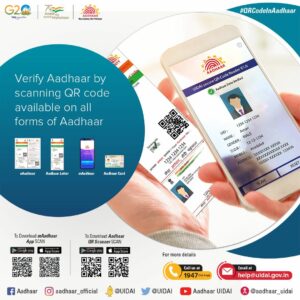Introduction
UIDAI – Unique Identification Authority of India: Following the Aadhaar Act 2016, the Indian Government created the Unique Identification Entity of India (UIDAI), formally recognized as a legislative authority, on July 12, 2016. UIDAI has eight regional offices across India, and its main office is in New Delhi.
The UIDAI
The Unique Identification Authority of India is also a statutory body established on July 12, 2016, by the Government of India, under the guidance of the Ministry of Electronics and Information Technology, following the supply of the Aadhaar (Targeted Delivery of Financial and also the Other Subsidies, Benefits, and Services) Act, 2016 (“Aadhaar Act 2016”). (MeitY). The Aadhaar and the Other Laws (Amendment) Act 2019 (14 of 2019) has modified the Aadhaar Act 2016 as of July 25, 2019.
To provide all Indian citizens with Unique Identification numbers (UIDs), also known as “Aadhaar,” UIDAI was established. The UID needed to be both (a) strong enough to eliminate duplicate and false identities and (b) efficiently and affordably verifiable and authenticatable. As of October 31, 2021, 131.68 billion Aadhaar numbers had been distributed to Indian citizens by the Authority.
According to the Aadhaar Act of 2016, UIDAI is in charge of Aadhaar enrollment and authentication, which includes running and managing every stage of the Aadhaar life cycle, creating the policy, procedure, and system for issuing Aadhaar numbers to people, performing authentication, and ensuring the security of identity data and authentication records of people.

Historical Perspective
The Department of Information Technology and the Ministry of Communications and the Information Technology, Government of India approved the “Unique Identification for BPL Families” project on March 3, 2006. In light of this, a Processes Committee was established on July 3, 2006, to make recommendations regarding the procedure to be followed for updating, altering, adding, and deleting data and fields from the core database that will be developed as part of the Unique Identification for BPL Families project. On 26-11-2006, this committee produced a document titled “Strategic Vision Unique Identification of Residents.” Based on this, the Empowered Group of Ministers was established on 04-12-2006, to compile the National Population Register following the Citizenship Act of 1955 and the Department of Information Technology’s Unique Identification Number project.
Following its Gazette Notification No.-A-43011/02/2009-Admn.I) dated January 28, 2009, UIDAI was operating as an attached office of the former Planning Commission (now NITI Aayog) before its establishment as a statutory authority. The first UID number was given to a resident of Nandurbar, Maharashtra, on September 29, 2010. To attach the UIDAI to the Department of Electronics and Information Technology (DeitY) of the former Ministry of Communications and Information Technology, the Government revised the Allocation of Business Rules on September 12, 2015.
The Planning Commission, now known as the NITI Ayog, originally had the UIDAI as a division. The first UID, also known as an Aadhaar, was issued to a resident of Nandurbar, Maharashtra, in 2010. The Government modified the “Allocation of Business Rules” in 2015 to include UIDAI under the Department of Electronics and Information Technology’s supervision.
The organization is now managing all phases of creating the Aadhaar Card life cycle, including enrollment, authentication, and management.
Goals of the UIDAI
The primary goal of UIDAI is to assign each person a 12-digit unique identification number (UID) to:
- Get rid of duplicate identities
- Cost-effectively verify and authenticate the identity
UIDAI Services Offered
1. Enrolment
- Locating an enrolment center
- Checking the status of Aadhaar
- Downloading Aadhaar
- Retrieval of UID/ Enrolment ID (EID)
- Order Reprint
- Updating Details
2. Update information online
- Update via post
- Update at enrolment center
- Checking off ‘update status.’
- Requesting address validation letter
- Online address update status
- View update history
3. Other Services
- Verification of Aadhaar number
- Verification of mobile number and email ID
- Locking and unlocking of biometrics
- Aadhaar and bank account link status check
- Logging of complaints
- Checking the status of complaint\
- Virtual ID generation/retrieval
- Paperless e-KYC
- SMS services
Principles of UIDAI
- Sound Government
- Integrity
- Embedded nation-building
- Make an effort to deliver high-caliber services
- Pay attention to lifelong learning and quality improvement
2016 Aadhaar Act
The “Aadhaar Act 2016,” also known as the Aadhaar (Targeted Delivery of Financial and Other Subsidies, Benefits, and Services) Act, 2016, was enacted on March 25, 2016. The Act’s main highlights are listed below:
Any Indian resident may obtain a 12-digit Aadhaar number by providing demographic and biometric data. Once issued, an Aadhaar number cannot be transferred to another person. The Central Government established the UIDAI as an Authority to manage tasks delegated by the Act. The process known as “authentication” entails sending the Aadhaar number, along with demographic and biometric data, to the Central Identities Data Repository for validation.
Ecosystem UIDAI
Registrars and enrolment organizations are a part of the system and aid in enrolling people. The UIDAI recognizes Registrars and names enrollment organizations to assist in gathering biometric and demographic data.
Registrars: UIDAI has a registrar for enrolling people in Aadhaar and is a partner of UIDAI under an MoU. These registrars either handle every enrollment process or contract out enrollment services. The people provide them with all the information they require. They must also carry out the tasks and obligations delegated to them.
Enrolment Agencies: Using designated supervisors and operators, the enrolment agency authorized by the registrar collects biometric and demographic data from individuals during the enrolment process. These organizations are in charge of establishing enrollment centers and updating and rectifying data.
Division of Finance & Accounts for UIDAI
The division’s accounts and finances are under the control of UIDAI’s Deputy Director General (Finance). The finance divisions are responsible for annual account preparation, cash management, performance and outcome budgets, and budget development for UIDAI. The Finance Division provides knowledgeable advice to the Chief Executive Officer (CEO) of UIDAI on all issues that impact the organization’s finances.
Vision
The body’s primary goal is to make it possible for anyone with a UID and a digital platform to authenticate themselves at any time and from any location.
- Effective subvention delivery enables good governance.
- Adherence to the 2016 Aadhaar Act
- Establish a procedure for assigning, validating, and updating Aadhaar numbers.
Mission
- Enable the security and confidentiality of data related to identities.
- To provide Aadhaar cards to all citizens of India while upholding stringent quality standards and turnaround times.
- To guarantee the scalability and availability of the technical infrastructure.
- To create a long-lasting organization that would uphold and advance the principles and goals of UIDAI.
Organizational Structure of UIDAI
Eight Regional Offices (RO) are spread across India, and UIDAI’s main office is in New Delhi. The two UIDAI data centers are in Gurugram’s Manesar and Bengaluru’s Hebbal, respectively.
Personnel from the UIDAI
- Saurabh Garg, the Authority’s Chief Executive Officer (CEO), serves as the organization’s legal and administrative representative.
- Persistent Systems’ founder, chairman, and managing director, Anand Deshpande, has been appointed to the UIDAI as a part-time member.
Division of Finance and Accounts: Function
The following are the chief responsibilities of the UIDAI’s Finance and Accounts Division:
- Concurrence or Advice on Finance
- Internal Audit Drawing and Disbursement Management Expenditure and Cash Management Bookkeeping Budget Preparation
- mAadhaar
- The mAadhaar mobile app was created by the Unique Identification Authority of India and is available for download from the Google Playstore.
The application provides the following services:
Only those who have a registered mobile number can create an Aadhaar profile.
- Your biometrics can be locked and unlocked.
- Generation of a virtual ID
How do you set up your m-Aadhaar app profile?
Step 1: Enter the 12-digit Aadhaar number in the first step.
Step 2: Check that your mobile data connection is active, enter your information, and click the “Verify” button.
Step 3: Your registered mobile number will receive an OPT.
How does the m-Aadhaar app generate a virtual ID?
Step 1: Select the “VID Generation” button from the side menu.
Step 2: Create a VID or use one that already exists.
Step 3: The VID for UIDAI’s Grievance Redressal can be seen on the screen.
Through the Contact Centers UIDAI setup, any questions or complaints regarding Aadhaar enrollment and Aadhaar updating can be addressed.
For grievances:
- Use the toll-free number 1800 300 1947 to contact us.
- Email help@uidai.gov.in with your inquiry.
- Or submit a grievance.
- Additionally, complaints may be filed by mail or online at https://pgportal.gov.in.
The UIDAI Government website, UMANG App, DigiLocker, mAadhaar App, and many other methods are now available to download and print your Aadhaar whenever it suits you.
FAQs
What is the e-Aadhaar password?
Your birth year and the first four capital letters of your name will serve as your password. However, the first four letters might be optional, depending on the name. If your name is Aditya and you were born in 1992, your password would be ADIT1992. If your name is Lee and you were born in 1995, the password would be LEE1995.
What is Aadhaar with a mask?
When you download the e-version of your Aadhaar, Mask Aadhaar enables you to hide the first eight digits of your Aadhaar number. When you mask your Aadhaar, the first eight digits are changed to xxxxxxxx, and the final four digits are added. This increases security.
My cell phone number needs to be updated. How can I go about doing that?
Visit the Permanent Enrolment Center if you want to change your mobile number.
Is it feasible to update the address in my native tongue?
You can indeed change or update your address in your native tongue. Assamese, Bengali, English, Gujarati, Hindi, Kannada, Malayalam, Marathi, Odia, Punjabi, Tamil, Telugu, and Urdu are the languages in which you can update your address.
I need documentation to support my address. Can I still change my Aadhaar address?
Yes, even if you lack the necessary paperwork to prove your address, you can still update your address in Aadhaar with the help of an Aadhaar verifier by submitting an online request for an Address Validation Letter. You can edit the address with the address of your current residence if a family member, friend, landlord, or anyone else allowing you to use their address as proof of residency agrees to act as the address verifier.
How do I proceed if I misplace my UIDAI Aadhar card?
If you lose or misplace your Aadhar card, you can obtain a duplicate by downloading the e-Aadhar/PDF from the UIDAI website.

Can you tell me where is the exact location that my aadhar card gone because it is not here. I have gave the address of this place but since it is not here
contact uidai enrolment centre where u have applied for aadhar